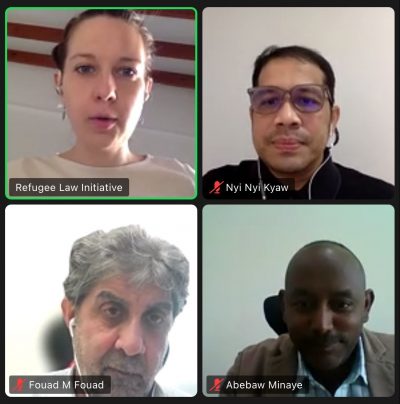The online “Internal Displacement and Solutions” conference took place from March 14-15, 2024 and marks the culmination of five years of increasing international engagement with the pressing challenge of ‘solutions’ to internal displacement.
In 2024, the UN Secretary-General’s Special Adviser on Solutions to Internal Displacement will wrap up the work on this issue begun by his High-Level Panel in 2020 and continued under his Action Agenda. These processes reflect a longstanding preoccupation that, despite decades of efforts including the 1998 UN Guiding Principles on Internal Displacement and the humanitarian reform, the acute needs of many internally displaced persons (IDPs) remain unmet and, globally, long-term solutions to their situation appear elusive.
 This conference provides a forum for researchers, practitioners, policy-makers and students from all disciplines to come together to present, debate and reflect on ‘solutions’ to internal displacement and their future. It offered the chance to develop new research agendas and collaborations. Alongside keynote presentations, it hosted ‘thematic’ and ‘open’ panel sessions to share research and analysis from academia and from policy/practice.
This conference provides a forum for researchers, practitioners, policy-makers and students from all disciplines to come together to present, debate and reflect on ‘solutions’ to internal displacement and their future. It offered the chance to develop new research agendas and collaborations. Alongside keynote presentations, it hosted ‘thematic’ and ‘open’ panel sessions to share research and analysis from academia and from policy/practice.
IDRC Research Chairs, Dr. Nyi Nyi kyaw, Dr. Abebaw Minaye, and Dr. Fouad M Fouad, presented at the “Not All IDPs are the Same: Working towards Different ‘Solutions’ for Different IDPs” thematic panel sessions.
Not All Myanmar IDPs (2011-) Are the Same
Speaker: Dr. Nyi Nyi Kyaw (IDRC Research Chair, Chiang Mai University, Thailand)
This paper will discuss three different waves of internal displacement of more than 2 million in Myanmar from 2011 until late 2023 and highlight that ethnic conflict, religious conflict, and political conflict have resulted in those waves. It will then argue that different solutions are required and must be tailed to help solve the three waves.
Seeking Solutions to Unprecedented Internal Displacement in Ethiopia
Speaker: Dr. Abebaw Minaye (IDRC Research Chair, Addis Ababa University, Ethiopia)
The multidimensional plights of close to 4 million IDPs in Ethiopia have taken a back seat in the policy debates in the country. Ethiopia has not adopted adequate legal and institutional frameworks for the protection of IDPs (Djigisa, 2019). Neither does the international community pay sufficient attention to the problem. Ethiopia lacks a comprehensive dedicated framework to ameliorate the plight of IDPs. One of the most relevant provisions was the Disaster Risk Management (DRM) policy of 2013 with its associated Strategic Programme (Habte & Kweon, 2018). Though Ethiopia has ratified the Kampala Convention, there is neither a legal nor policy framework that gives domestic effect to the Convention. Though Ethiopia has recently joined the UN’s Durable Solutions Initiative (2019), existing normative frameworks do not comprehensively respond to the specific needs of IDPs (Dagne, 2021), and transitional, developmental and durable solutions are not being implemented properly. Sometimes pushes by the government for IDPs’ return to their original environments that remain violent do more harm than help. In some cases, IDPs are experiencing emotional statelessness. Focus is often much more on charity, where the private sector is required to give alms, than on creation of business and entrepreneurial activities that benefit and empower IDPs. I want to discuss the following possible solutions. First, engagement and representation of IDPs in community-based organizations to help them articulate their concerns and possible mitigation strategies. Second, government should better cooperate with host communities by aligning support to IDPs with local development endeavours than pressuring IDPs to return. Third, addressing systemic threats for example by respecting the rights of ethnic minorities in ethnic majority regions and revising federal and regional constitutions. Fourth, embracing a whole-of-government approach that engages various sectoral government offices with better coordination mechanism so that no one will be left behind.
IDPs in Northwest Syria – How to Address Need in Non-State Entity
Speaker: Dr. Fouad M Fouad (IDRC Research Chair, American University of Beirut, Lebanon)
Syria has the highest number of internally displaced people (IDPs) in the world, with 6.7 million people being forced from their homes since the uprising began in 2011. Women and children constitute at least two-thirds of those who are displaced. The IDPs are unevenly distributed across the four primary territories controlled by various conflict parties, with only one being under government control. Each of these territories has evolved differently, with different leadership and governance structures, financing, and priorities. I will argue that the 2.5 million IDPs who crossed the power borders (but not the international borders) to northwest Syria, which is governed by non-state groups, require a different solution to address their needs when compared to IDPs who moved within territories controlled by the government.
View the conference programme for a full list of panel sessions, keynote speakers, and hosts: